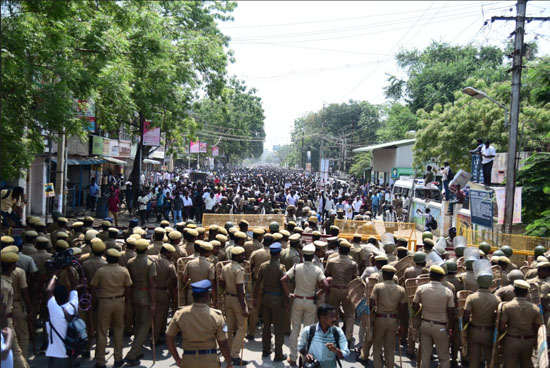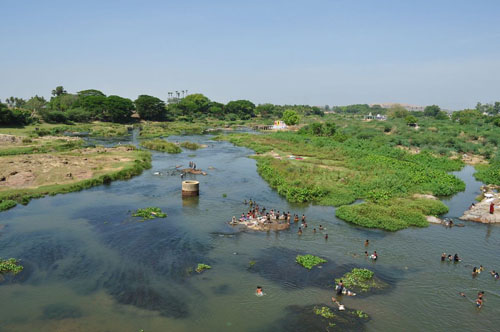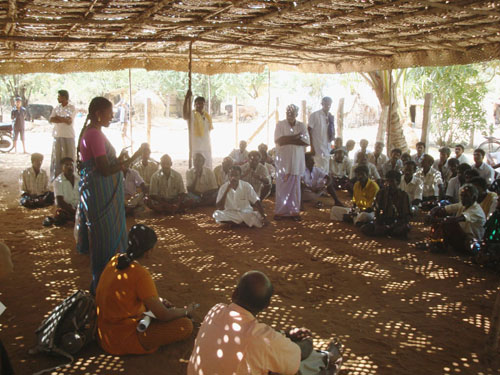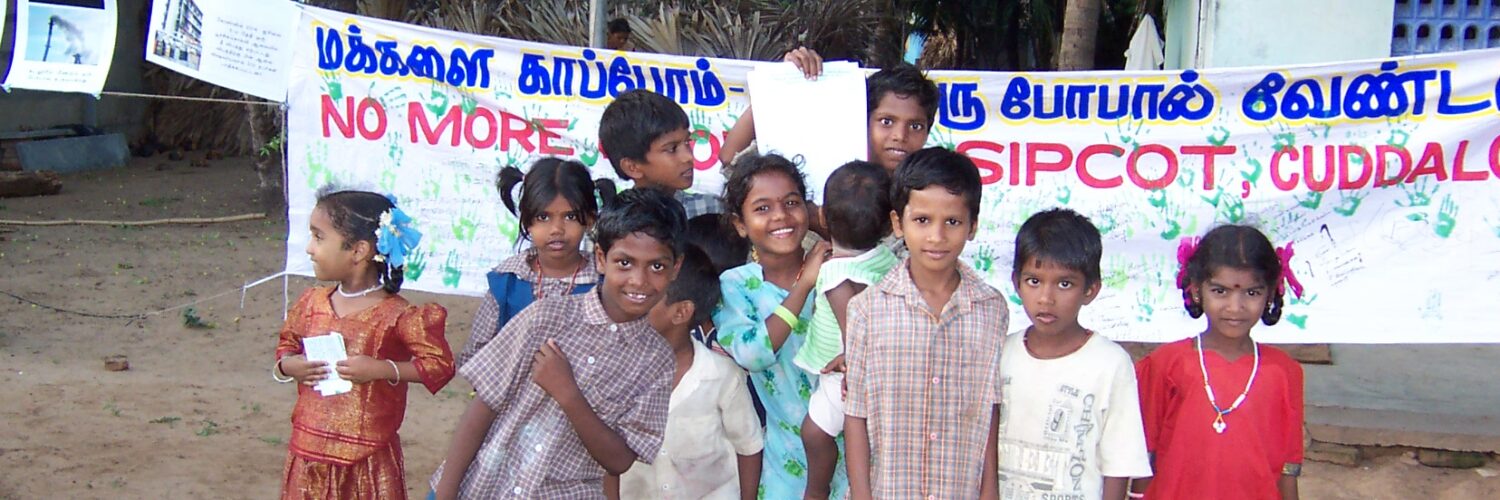The Wire
The killing of anti-Sterlite protestors in Thoothukudi may have been warning shots, but the protesters have also made themselves heard: development can’t come at the cost of environmental health.

Scenes of protest for the 100th consecutive day in Thoothukudi against the Sterlite unit, May 22, 2018. Credit: Surya, Tuticorin
19/JUN/2018
Chennai: The Tamil Nadu Government has announced a ban on the use of plastics from January 1, 2019. This is a remarkable move aimed towards reducing the amount of plastic waste generated in the state. But is this enough to save the environment in the state?
This announcement came barely a fortnight after the brutal killing of 13 people protesting against the Sterlite Copper unit in Thoothukudi. Sterlite Copper is one of the largest contributors to environmental pollution in Thoothukudi district but not the only one. The Geological Society of India, in a journal article published in July 2017, stated, “Spatial interpolation of inverse distance method maps of all the elements suggested that discharge of effluents from chemical factory, municipal wastewater and fertilizers were added to the natural sources.”
This indicates that though Sterlite Copper may have been closed, there is no assurance that the pollution in the city is under control. As a result, the need for a peoples movement to save Thoothukudi persists, as does the need for similar movements across the state.
Thoothukudi is not alone in its suffering, nor is its peoples movement the first of its kind in Tamil Nadu. The state has had a legacy on this front right since the days of Periyars self-respect movement in the 1920s. The people of Tamil Nadu have never hesitated to raise their voice against injustice, fight for their rights and organise against the establishment.
It is also not surprising that many of these movements in recent times are founded on environmental protection above all else. Having lost trust in lawmakers both bureaucracy and politicians the people have found their own ways to securing their rights and livelihood. They dont ask for the support of popular leaders or the backing of political parties. They have often been met with physical, legal and mental oppression by the state. A few have succeeded; many others fight on. Thanks to the martyrs of the Sterlite protest, the issue has now received global attention.
The people of Cuddalore are waiting for this movement. The State Industries Promotion Corporation of Tamil Nadu (SIPCOT) unit in Cuddalore was established in 1984 for chemical industries, over 518.79 acres of land. Since then, the groundwater in the compound and in surrounding areas has become polluted and unusable. According to an analysis by the SIPCOT Area Community Environmental Monitors (SACEM) in 2014, the groundwater in and around SIPCOT contains carcinogenic chemicals and is unfit for human consumption.
SACEM also reported that people who had consumed the water have reported abdominal pain, nausea, vomiting, intestinal bleeding, affected kidneys, bones, lungs, liver and nervous system and cancer, irritation and ulcers in the stomach and small intestine and anaemia and slower growth rate and mental development among children. Including SACEM, there are various groups agitating for more than 10 years to have SIPCOT closed.
In similar vein, the SIPCOT unit in Mettur has a number of chemical factories, of which Chemplast Sanmar is a major manufacturer of PVC resins, caustic soda, refrigerants and industrial salts. It has allegedly been releasing untreated water into the Cauvery river, on whose banks Mettur is located, for the last two decades or more. At first, public perception of the factory was centred on its providing jobs for the local people. But once local residents reportedly noticed a heightened incidence of cancer and reproductive issues, it shifted. The resistance, made up mostly of women, has been fighting against Chemplast plant for 20 years.
Abusing rivers

The Thamirabarani river flows through Tirunelveli. Credit: Karthikeyan.pandian/Wikimedia Commons, CC BY-SA 3.0
When the Sanmar group wanted to open another plant in Cuddalore in 2005, members of this movement travelled to Cuddalore and spoke to their compatriots living around the SIPCOT premises in attempt to have them block the project.
However, Chemplast Sanmar has categorically denied all of these allegations. In a statement sent to The Wire, Ramkumar Shankar, the managing director of the company, elaborated that the Mettur plant has had an effluent treatment plant on site since the 1960s conforming to standards set by the Tamil Nadu Pollution Control Board, and that in 2007, it was augmented by a zero liquid discharge (ZLD) plant. “The discharge point of the pipe that was earlier used to discharge treated effluents has been closed with concrete and this has been verified by local authorities as well,” Shankar wrote. He also added that Chemplast Sanmars Cuddalore unit also has a ZLD and desalination plants. “Since the inception of the Cuddalore plant in 2009, not a single drop of water has been drawn from the ground, nor has any effluent been discharged into the ground or any water body.”
The founding premise of factories typically focuses on employment. But the cost they have imposed on their neighbourhoods is too much to bear. Two rivers, the Palar and the Noyyal, have already been devastated by industrial units situated on their banks.
The Palar originates in Karnataka and flows through Kancheepuram and Vellore districts. Once the primary source of drinking water and irrigation for the North and South Arcot regions, the river has been mostly dry for most of the year for the last two decades. Only streams of wastewater flow in the Palar, while the sand from its bed is robbed for its minerals. In 2008, the Social Action Movement and Water Rights Protection Group, Chengalpattu, released a documentary titled En Peyar Palar (My name is Palar) to highlight the rivers plight, and to draw attention to the Palar as well as a social movement growing to protect it. However, the government has not paid them much attention.
Smaller rivers like the Cheyyar and the Arisilaaru and the larger ones like Cauvery and Kollidam have also been plagued with sand-mining.
Pugalur, a small village on the banks of the Cauvery in Karur district, is crowded with lorries lining up to transport river sand. The people of Pugalur have been fighting this menace for the last five years. In conversations, they have reported being threatened by mining conglomerates unafraid to brag about their political connections. Many protesters have been beaten up; some have even been run over while trying to stop the lorries, but to no avail: the government doesnt seem to have cared nor the national media.
The Noyyal flows through Thiruppur, Tamil Nadus textile capital, and as such has been treated as a drainage channel. In September 2017, the river spewed froth onto
Thiruppurs streets, which floated into homes and offices. A February 2016 study by a researcher from the University of Madras found that more than half of the people interviewed in the city reported health problems like diarrhoea and cholera, while more than 75% said they suffered skin diseases.
In 1995, four years after the Orathapalayam dam was built on the river, farmers downstream objected to the waters release, which had become contaminated from the dyeing and bleaching units upstream. They filed a case in the Madras high court the following year. In 1997, the court ordered that dam water should not be released for irrigation. It was because of the peoples movement that at least 160 units were shut down, and an effluent treatment plant installed. However, the rivers abuse continues unabated.
Further south, the Thamirabarani is a perennial river in Tirunelveli district. Coke and Pepsi bottling plants were set up in the Gangaikondan SIPCOT, and a government order in 1998 allowed SIPCOT to draw three million gallons of water per day from the Thamirabarani. Subsequent, two public interest litigations were filed in the Madurai bench of the Madras high court seeking a permanent ban on river water use by the bottling plants, but they were dismissed in 2017, and the companies continued to draw water from the river.
In December 2017, the Papanasam dam built on the river was almost full: there was water up to 123 feet against its maximum capacity of 143 feet, thanks to heavy rainfall. But on May 5, 2018, the water level was 20.6 feet. Where did the water go? It could not have been released for irrigation because the logs in the Manimuthar dam, about 18 km away, tell a different story. The water level in Manimuthar crossed the 100-feet-mark on December 1, 2017. On May 5, 2018, it was at 76.44 feet. The is just 23 feet between December and May, as against the difference of 122 feet in Papanasam in the same period. The farmers of the district suspect that the water was released to the Coke and Pepsi plants.
Lakes fare no better

The flooded ground along Old Mahabalipuram Road in Chennai following two days of cyclonic rains in the city. Credit: Vijay Thamarai
The plight of lakes is also deeply concerning. Tamil Nadu is historically known for lakes called eri (pronounced ‘aeri’) and its irrigation and draining functions. These lakes are interlinked as well as linked to different rivers and drain their waters.
In 2011, the Tamil Nadu government passed an act declaring encroachments on water bodies illegal. However, most lakes in the state had already been encroached upon, in many cases by government establishments such as colleges, bus stands in Villupuram and Tirunelveli, court premises, administrative offices, highways, etc. One of the earliest such encroachments was the Aringyar Anna Government Arts college in Villupuram. It was built in 1968 on a lake as the Madurai bench of the high in Madurai. Ironically, all these buildings have rainwater harvesting facilities.
When the Tamil Nadu portion of the Golden Quadrilateral was built, many water bodies were encroached. The Trichy-Karur four-lane bypass was set to encroach upon four
lakes: Piratiyur eri, Punganoor eri, Kallikudi lake and Thaiyanur lake, which are irrigation sources. Officials had planned for the road to divide these lakes into two segments, which means the road was to be constructed in the middle of these lakes.
The Tamil Nadu Agriculturists Association, represented by its organiser M.P. Chinnadurai; the Punganoor Eri Farmers Welfare Association, represented by K.R. Periyasamy Udayar; and an individual farmer named G. Selvakumar filed writ petitions against this proposal. On Novemner 9, 2010, the Madurai bench ordered that these lakes are to be preserved and, if necessary, the road could be built as a bridge over these lakes.
Notwithstanding this singular case, many newly built roads in the state have split several water bodies into two. Many ecologists have said that palm trees grown on the banks of the eri have strong roots and hence protect against erosion. The sight of a row of palm trees anywhere indicates the presence of a water body nearby. In the same vein, when you travel on a road flanked by palm trees on either side, you can be sure that the road has cut some water body in two.
In spite of the 2011 Act passed by the Tamil Nadu government, lawmakers have themselves encouraged the encroachment of water bodies.
In Kanchipuram district, still renowned for its lakes, a large number of interconnected lakes were constructed for irrigation purposes in the Pallava period (275-897 CE). They were connected to different rivers, including the Adyar.
The advent of the Greater Chennai project, most blocks of Kanchipuram district, especially those close to the Outer Mahabalipuram Road, precipitated a real-estate boom, especially over the last two decades. This has resulted in the encroachment of numerous water bodies and, of course, groundwater depletion.
Perhaps the most concerning encroachment was upon the Pallikaranai marshland, in South Chennai. Starting from Tidel Park, setup by the state government in 2000 to foster innovation in IT, the Pallikaranai marshland has been invaded by both governmental and private constructions. A large portion of the remaining area has been transformed into a landfill, used to dump garbage collected by the Chennai Corporation.
Many local waterbodies have also had private residential complexes built atop them. The effect of these encroachments was evident when the city flooded in December 2015, when these complexes were either underwater for many days or turned into islands. It was only after those floods that the government took measures to restore and revive the lakes and parts of the Pallikaranai marshland. Different NGOs have since been working on reviving the waterbodies and have also been engaged in creating awareness and prevent further incursions.
On the other hand, North Chennai is very polluted thanks to the presence of different industries. The Ennore creek in this part of the city has been gravely polluted by untreated wastewater and effluents. Once a flourishing mangrove swamp, it has now been reduced to small patches with no or little fish. One of the major contributors to this crisis is the North Chennai Thermal Power plant, also known as the Ennore power plant, which dumps its fly ash into the creek. A number of people have joined hands with the residents of Ennore to fight this nuisance, including Ramon Magsaysay award-winner T.M. Krishna. His Poramboke song was released in January 2017 to save Ennore creek.
Against nuclear and neutrino projects

At a meeting organised by the INO collaboration with villagers from Pottipuram, Theni. Credit: INO
Similarly, the recent protests against the Kudankulam Nuclear power plant, methane and hydrocarbon projects in the Cauvery delta and the neutrino experiment project in Theni district have also received wide attention. This has created the impression that the people of Tamil Nadu are against all development projects but the truth is that they have all risen up in protest together, and late.
Tamil Nadu is not a water-surplus state. It relies on rainfall and storage structures like dams and eri for its drinking water and irrigation. With rivers polluted and lakes encroached, the state with few options. Setting aside agricultural needs for a moment, it is frightening to imagine what the people of Tamil Nadu will do for drinking water in thirty years (considering a NITI Aayog study has already found that India will only have half the water it needs by 2030).
Many urban centres, such as Dindigul, are on the cusp of complete groundwater depletion. Chennai and Madurai are getting there fast. Today, a major portion of Chennais drinking water comes from around the city, not from within, and the water-table in these parts has been falling. Official announcement or not, Tamil Nadu is a water-stressed state in 2018. Against this background, it is painful to note that the developmental and industrial projects proposed or executed by the government are either highly water-polluting or water-consuming.
Consider the case of the India-based Neutrino Observatory (INO) proposed to be set up in Theni. This district is known for its production of vegetables and fruits, and is a major supplier of such foods to Kerala. However, Kerala has denied Tamil Nadu water from the Mullai Periyar Dam. The Tamil Nadu government filed a case to raise the dams storage level. In 2015, the Supreme Court ruled in its favour: the water level was raised. Thankfully, that year, there were also heavy rains and the dam filled up. But the farmers joy didnt last long.
People in the area have been concerned that the INO will use 3.4 lakh litres of water a day once it becomes operationalised, and farmers have come out in protest. While they have agreed that setting up the INO would be a matter of national pride, they have also petitioned that it should have been situated in a water-surplus district, and not in a place like Theni, which has only just started receiving water from the Mullai Periyar. The INO is currently in a suspended state.
Onto nuclear: Did you know that Tamil Nadu is the only state in India to have two nuclear power projects? They are located at Kalpakkam (71.3 km south of Chennai) and Kudankulam (35.6 km north of Kanyakumari).
The villagers of Manavalakurichi, located about 64 km from Kudankulam, have been complaining of higher incidence of cancer and epilepsy and have been blaming the mining of beach sand, for radioactive minerals to feed nuclear reactors.
Pukalenthi, a medical doctor who has been working with Dalits and fisherfolk in Kalpakkam since 1989, was one of the first members of the anti-nuclear movement in Tamil Nadu, apparently motivated by having treated cases of radiation poisoning for almost 30 years. He joined S.P. Udayakumar, who had founded the movement only a year prior, and together they mobilised thousands of people in the area after the Fukushima nuclear disaster in 2011.
Idinthakarai, a village close to the Kudankulam nuclear power plant, became the protests ground-zero. Here, Udaykumar and others organised a hunger strike in
shifts, observed for over 500 days. At the same time, in early 2012, the government imposed a curfew in all villages within a seven-kilometre radius around the plant. In further effort to break up the gathering, the government mobilised the Coast Guard and police personnel on the ground in September 2012, and assaulted protesters. Two fishermen, Sahayam Francis and Antony John, were killed in the attack. Criminal cases including that of sedition were also filed against members of the Peoples Movement against Nuclear Energy.
A beleaguered delta
The Cauvery delta in Tamil Nadu, spread over Thanjavur, Thiruchirapalli, Nagapattinam and Thiruvarur districts, has been reeling under the dispute between Karnataka and Tamil Nadu in sharing the rivers water. Once considered the ‘rice bowl of Tamil Nadu’, people in the area have been giving up farming due to lack of water. In this scenario, the state government floated three energy projects here: a hydrocarbon extraction unit in Neduvasal, a methane extraction project in Thanjavur and a Gas Authority of India, Ltd. (GAIL) pipeline in Nagapattinam.
Protests against the methane project were led by T Jayaraman, a retired professor and a veteran social activist from Mayiladuthurai, and G. Nammalvar, a renowned agricultural scientist and environmental activist (he passed away in 2013). Jayaraman has been arrested several times and charged under the Goondas Act. The principal protest itself began in 2010 and ended in 2016, when the government suspended the project.
The campaign for this protest fed into the protest against the hydrocarbon extraction project in Neduvasal, and for which many undergraduate and graduate students had also signed up. One of them, Valarmathi, was arrested and charged under the Goondas Act in July 2017, along with several others charged with different, but unspecified, crimes.
The GAIL pipeline project was vehemently opposed by the farmers of Nagapattinam, after they refused to give up their land for the project. GAIL subsequently said in a statement that the state government would have to obtain licenses from the landowners for it to be able to lay its pipes at a depth of one metre below ground, following which the land would be given back to the farmers. It also stated that some restrictions would be imposed on certain types of construction in the vicinity this land but that the cultivation of crops could continue as normal. However, the land acquisition agreement stated that no trees could be planted within 30 metres on either side of the pipeline.
In February 2016, J. Jayalalithaa, then the chief minister of Tamil Nadu, wrote to Prime Minister Narendra Modi that “the project would very adversely affect lakhs of mango, jackfruit and coconut trees which are extensively grown in the project affected areas. It is estimated that more than 1,20,000 such fruit bearing trees would have to be uprooted for laying the pipes.” GAIL then took the matter to court, and there it currently stands.
In similar vein, a protest by the villagers of Kathiramangalam, Thanjavur district, reached its one-year mark on May 19, 2018. The people have been agitating against an oil leak in July 2017 in infrastructure managed by the Oil and Natural Gas Corporation (ONGC) in the area. V.P. Mahawar, the onshore director of the unit in question, had said in a press conference at the time, "Two thousand litres of crude oil and 18,000 cubic metres of gas leaked out of the well. The total area affected is close to one acre.” Here as in Thanjavur protestors were booked under the Goondas Act, and the protest itself continues.
Finally, the mercury poisoning in Kodaikanal and the extent of environmental abuse in the district (of Dindigul) received some public attention following the release of ‘Kodaikanal Won’t’, a rap song video by Sofia Ashraf. Unilever, which had operated a factory in the town to manufacture mercury-based thermometers for export, was shut in 2001.
